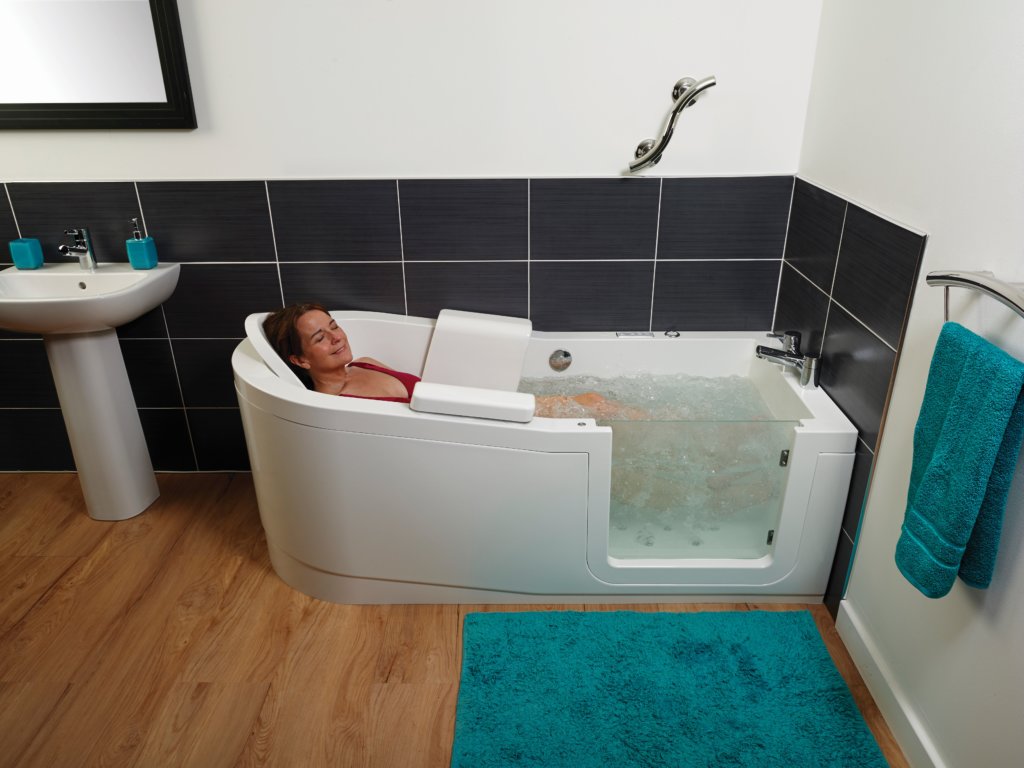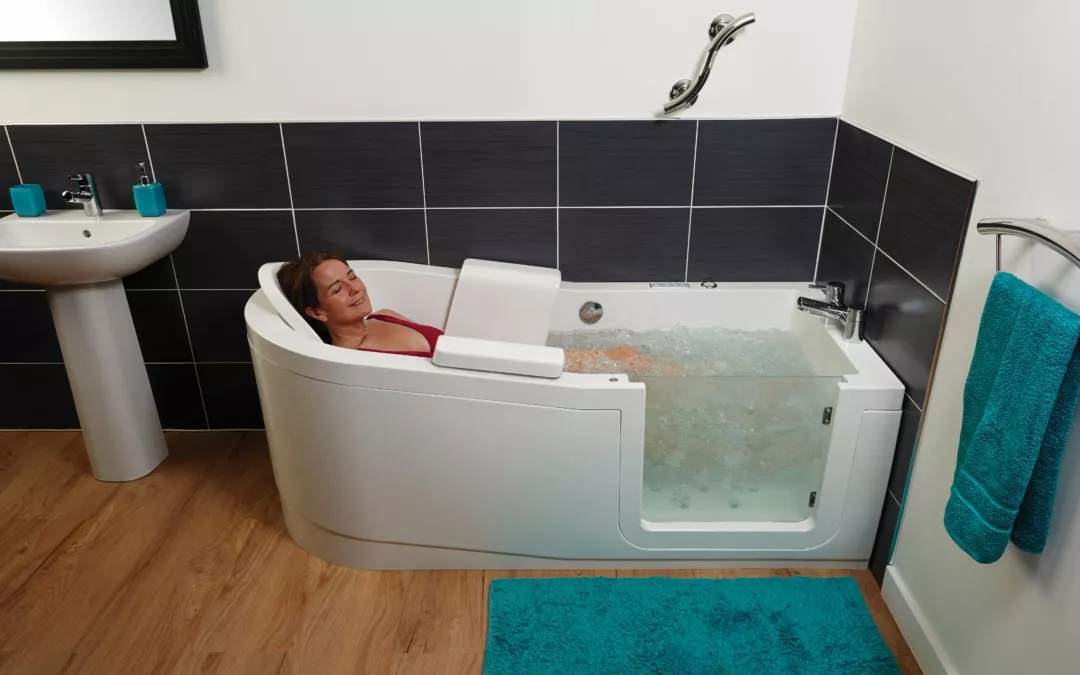
The use of water in therapy has benefitted many for hundreds of years across numerous cultures, and for good reason. From Roman Baths to hot mineral springs, the healing properties of water are now an integral part of both traditional medical and alternative practices.
Doctors and other health professionals often prescribe a course of hydrotherapy as part of a treatment program. Sessions of hydrotherapy are also used by athletes and sports enthusiasts to improve and maintain their overall health, performance and fitness, and by others as part of a holistic whole-body practice.
For those who struggle to perform certain activities on dry land, there is a huge sense of independence and achievement gained from using hydrotherapy techniques. The benefits of aquatic therapy certainly extends beyond the physical.
Get a FREE Brochure
Simply complete our form to see a full range of bathing solutions & their key features. It takes no time at all!
- What is hydrotherapy?
- Types of hydrotherapy
- Hydrotherapy benefits
- Who does hydrotherapy benefit?
- What to expect from hydrotherapy session
- How to make the most of hydrotherapy benefits
What is hydrotherapy?
Specifically, hydrotherapy is the use of water to relieve pain or discomfort and to promote overall well being. Also known as water therapy, hydrotherapy involves the use of water at varying temperatures, therefore includes such treatments as; saunas, steam baths, foot baths, contrast therapy, hot and cold showers, and physical water therapy.
Within the medical world, physiotherapists and other practitioners use hydrotherapy for common conditions such as arthritis or rheumatic ailments. Although aqua aerobics might spring to mind, hydrotherapy as a medical treatment is different. The movements are slower and tend to be more focused on the area of your body that needs support. These slow, controlled movements also have a relaxing effect.
Although each treatment differs slightly, within each different type of hydrotherapy, the water plays a key role.
Types of hydrotherapy
Hydrotherapy can take place anywhere from a spa, health centre, hospital or even at home with a walk-in bath.
Some common types include;
Contrast Hydrotherapy: First invented by the ‘Father of Hydrotherapy’, Sebastian Kneipp in the 19th century. Contrast hydrotherapy benefits when using alternating hot and cold water includes a decrease in inflammation and stimulation of circulation and lymphatic drainage. Many people often opt to use this treatment as part of their daily shower routine!
This treatment involves subjecting the body to a contrast of temperatures, i.e. hot then cold and can be performed in a variety of places, from the shower to a spa. There are simple methods to achieving contrast therapy, like an ice pack and heat pad. This method has been shown to help people recover quicker from exercise or injury, burn more calories, boost the immune system and potentially help some skin conditions.
Hydrotherapy Pool: These are special exercises you do in a warm-water pool. The water temperature is usually 33–36ºC, which is warmer than a typical swimming pool and more like a warm bath. The warmer water provides gentle relief to back pain or arthritis whilst also allowing some mild resistance without the need to fight gravity.
When in the warm pool, aquatic exercises are used as a low impact form of physical activity, sometimes using specialist equipment. The focus is generally working the muscles and raising the heart rate without putting too much stress on the joints. This can be particularly beneficial for those who have a higher risk of falling or just find working out a bit easier when it is low impact.
Compresses or Wraps: This therapy involves using towels and flannels soaked in water. Warm compresses promote good circulation and blood flow, which can ease stiff muscles. Cool compresses reduce inflammation, whilst cold wraps are used for common colds & skin disorders. The hydrotherapy benefits here come from covering the body in cold wet flannels, then a layer of towels and blankets. The body heats in response until you begin to sweat. The increased sweat levels then allow for the elimination of toxins and for the blood to increase in circulation. Compresses are a well-known form of hydrotherapy and easy to use at home. This is a great way to offer targeted relief when symptoms are mild. Use of essential oils in conjunction with a wrap may also support treatment.
Sauna & Steam Rooms: Saunas use dry heat whilst steam rooms are filled with humid air. Both promote sweating for the excretion of toxins and impurities as well as helping to ease muscle pains.
A Warm Bath: Easily the most widely used type of hydrotherapy in the home. Soaking in warm water in a bath for up to 30 minutes using remedies such as Epsom salts, mineral mud, aromatherapy oils, oats, ginger, moor mud, and dead sea salts can support skin and muscular-skeletal conditions
A Sitz Bath: This is a shallow bath in which you can use cold or warm water depending on the need. Health professionals may recommend this type of hydrotherapy after giving birth or for relief from haemorrhoids or cramps.
Immersion therapies: This type of hydrotherapy has gained popularity in recent years. It involves a person immersing themselves to find relief. Popular forms include cold plunge pools, hot tubs, whirlpool baths and ice baths.
Hydrotherapy benefits
The benefits of hydrotherapy are well documented, especially for supporting conditions common amongst the elderly. Here are our top 5 healing benefits of hydrotherapy:
1. Bolsters the immune system
Hydrotherapy is known to increase blood flow and the circulation of white blood cells around the body. This, in turn, allows lymph, (a fluid containing infection-fighting cells which also collects waste materials) to move through the body effectively. This modulates the immune system, helping to fight infections and other illnesses.
2. Relieves stress
A benefit of hydrotherapy often not given the platform it should, stress relief has incredible value when treating ailments in the body. Hydrotherapy treatment can be effectively used to treat illnesses caused by stress through benefits such as lowering blood pressure, maintaining normal blood sugar levels and improving sleep quality.
3. Relieves pain and reduces muscle tension
During our day to day lives, we are constantly battling the effects of gravity, which we feel more as we age. However, all this is eased when we step into water. The weightlessness you feel during a hydrotherapy treatment can increase your movement capabilities, relieve the tension held in the limbs and pressure on joints, as well as providing support for aching muscles. The clear benefit of hydrotherapy is that this stimulates the release of endorphins, the body’s natural pain reliever, further reducing any soreness in the muscles. Many people use this as a great way to recover post-exercise by having a long soak in a warm bath.
4. Rehabilitation for injuries and conditions
The use of heated water increases the blood flow, alleviating pain and improving circulation. This has been shown to help heal injured tissues, reduce swelling and support the rehabilitation of injured joints and muscles. Furthermore, hospitals are known to use hydrotherapy effectively in the treatment of many conditions such as;
- Lower Back Pain
- Hypermobility Syndrome
- Ankylosing Spondylitis
- Fibromyalgia syndrome
- Osteoarthritis
- Rheumatoid Arthritis
- Post fracture/orthopaedic surgery
5. Detox Benefits
The hydrotherapy treatments which encourage sweating, such as steam rooms, saunas or even a hot bath or shower, are inducing one of the body’s primary detoxification pathways and therefore helps to eliminate toxins. This has been shown to cleanse the body but further studies have also indicated how this can actually lower one’s risk of dementia and Alzheimer’s disease.
6. Improves Mental Health
According to the Centres for Disease Control and Prevention (CDC) water-based activities such as those included in hydrotherapy techniques can improve mental health outcomes for some people. Those with conditions where pain affects mood such as Fibromyalgia may find aquatic exercise in warm water reduces symptoms of anxiety and depression.
Who does hydrotherapy benefit?
So, experiencing buoyancy, being immersed or massaged in water relieves our bodies and minds in a variety of ways, but who does it benefit the most? It has commonly been used with issues such as;
- muscle pain, soreness and inflammation
- back pain
- pain relief
- anxiety and stress
- high blood pressure
- poor muscle and skin tone
- poor circulation
- headaches
- hip or other joint replacements (before and after the operations)
- muscle or ligament injuries; broken limbs
- spinal cord injury
- neurological conditions such as strokes or brain injuries
- rheumatoid arthritis, cerebral palsy, ankylosing spondylitis
What to expect from hydrotherapy session
If you are having prescribed hydrotherapy treatment, your GP or physiotherapist will hopefully give you an idea of what you’ll be doing, and this will depend on what your personal needs are and what injury or condition you have.
For example, if you have a severe or long-term problem such as a spinal injury or stroke – you will most likely have one-on-one guidance and assistance from a qualified therapist.
If you are taking part in hydrotherapy at a spa, you may find that this simply means you have access to their facilities rather than a treatment in itself. This will likely include baths, swimming pools, immersion pools, showers and whirlpools, in which to spend unsupervised time.
How to make the most of hydrotherapy benefits
Many seniors like to take advantage of hydrotherapy by attending a spa, health centre or even on a relaxing holiday. However, at Bathing Solutions, we can include hydrotherapy (or ‘spatherapy’) as a luxury option in your walk-in bath. Learn more about this and our other luxury options here.






